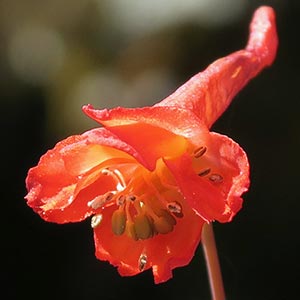Delphinium nudicaule
Delphinium tricorne
canyon delphinium, canyon larkspur, orange larkspur, red larkspur, red or orange larkspur, scarlet larkspur
dwarf larkspur, rock larkspur
(15-)20-50(-125) cm;
base reddish, glabrous.
20-60 cm;
base often reddish, nearly glabrous.
blade round to pentagonal, 2-6 × 3-10 cm; ultimate lobes 3-12, width 5-40 mm (basal), 2-20 mm (cauline).
blade round, 2-8 × 4-12 cm, nearly glabrous; ultimate lobes 3-18, 5 or more extending more than 3/5 distance to petiole, width 2-10 mm (basal), 4-10 mm (cauline), widest at middle or in proximal 1/2.
5-20(-69)-flowered;
pedicel (1.5-)2-6(-8) cm, glabrous to glandular-pubescent;
bracteoles 14-20(-30) mm from flowers, green to red, linear, 2-4(-9) mm, glabrous to puberulent.
5-15(-30)-flowered, less than 3 times longer than wide;
pedicel 1-2.5 cm, puberulent;
bracteoles 1-4(-6) mm from flowers, green, linear, 3-5 mm, puberulent.
sepals scarlet to reddish orange, rarely dull yellow, glabrous, lateral sepals forward-pointing to form pseudotube, (6-)8-13(-16) × 3-6 mm, spurs straight, slightly ascending, (12-)18-27(-34) mm;
lower petal blades elevated, exposing stamens, 2-3 mm, clefts 0.5-1 mm;
hairs sparse, evenly dispersed, yellow.
sepals deep bluish purple to pink or white, puberulent, lateral sepals spreading, 11-19 × 4-7 mm, spurs straight, within 30° of horizontal, 13-16 mm;
lower petal blades ± covering stamens, blue, except sometimes in white-flowered plants, 6-10 mm, clefts 0.5-2 mm;
hairs sparse, mostly centered near junction of blade and claw, white.
13-26 mm, 3.5-4.5 times longer than wide, glabrous.
14-22 mm, 4-4.5 times longer than wide, nearly glabrous.
unwinged or sometimes slightly wing-margined;
seed coat cells with surfaces smooth.
unwinged;
surface of each seed coat cell with 1-5 small, swollen, elongate, blunt, hairlike structures, barely visible at 20x, otherwise smooth.
= 16.
= 16.
Delphinium nudicaule
Delphinium tricorne
Delphinium nudicaule hybridizes with most other taxa of Delphinium that it encounters. Apparent hybrids involving D. nudicaule, and seen by the author (either afield or as specimens), include D. andersonii, D. antoninum, D. decorum, D. luteum, D. nuttallianum, D. patens, and D. trolliifolium. In addition, garden-grown plants have been hybridized with D. cardinale, D. elatum, D. menziesii, D. parishii, D. penardii, D. tatsienense Franchet, D. triste Fischer ex de Candolle, and D. uliginosum; D. nudicaule does not naturally occur with these species. Delphinium nudicaule is one of the earliest larkspurs to flower in any given locality. Douglas's type collection of D. nudicaule represents plants (synonyms D. sarcophyllum Hooker & Arnott and D. peltatum Hooker, an invalid name) grown under very moist conditions, probably quite near the ocean. The type specimen of D. armeniacum A. Heller represents plants grown under unusually dry conditions.
The Mendocino Indians consider Delphinium nudicaule a narcotic (D. E. Moerman 1986).
(Discussion copyrighted by Flora of North America; reprinted with permission.)
Delphinium tricorne is the most commonly encountered larkspur east of the Great Plains.
The Cherokee prepared infusions of Delphinium tricorne to ingest for heart problems, although they believed the roots of the plant made cows drunk and killed them (D. E. Moerman 1986).
(Discussion copyrighted by Flora of North America; reprinted with permission.)


